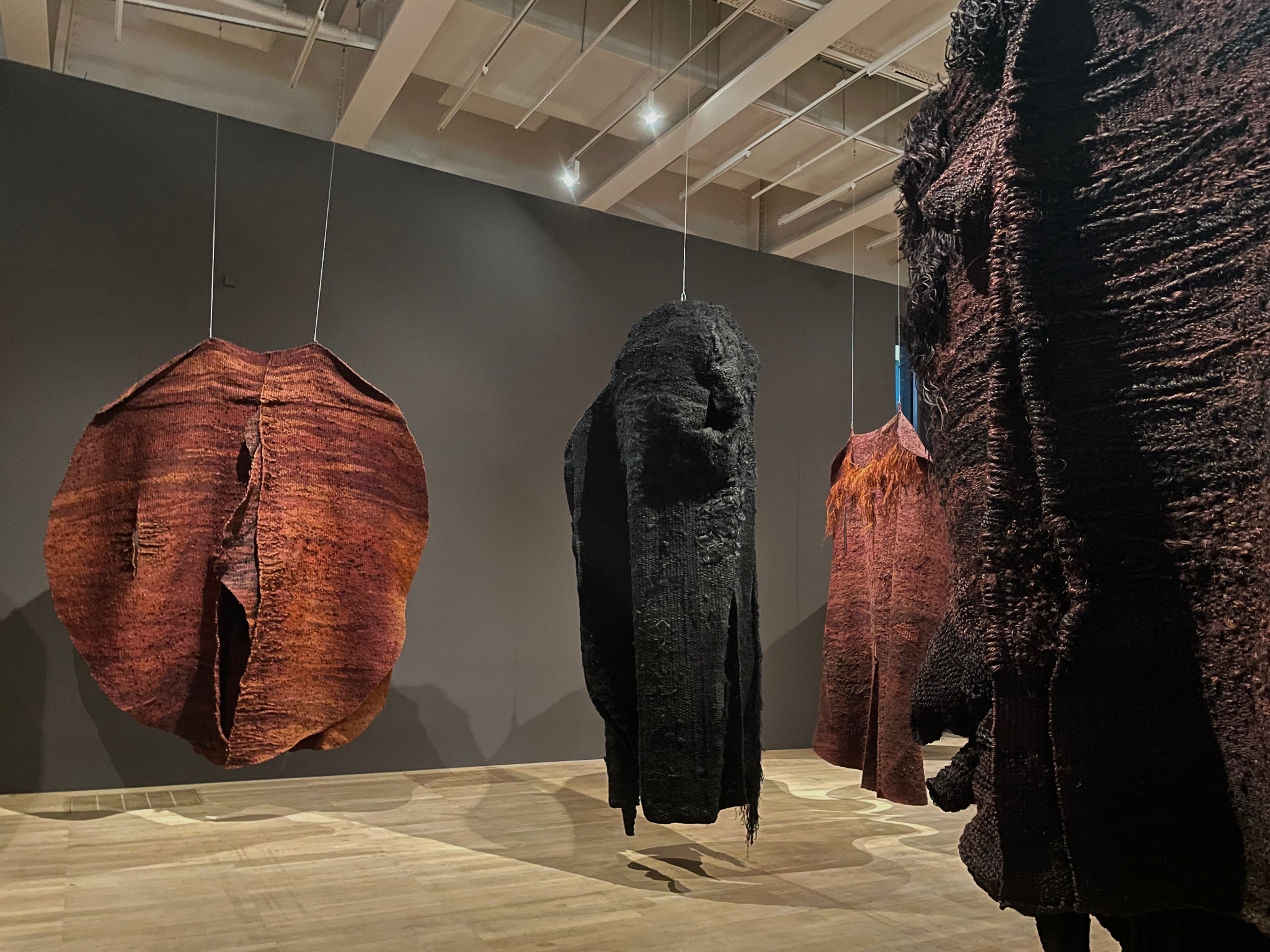Magdalena Abakanowicz’s ‘Every Tangle of Thread and Rope’ at Tate Modern
Split into six sections that culminate in an immersive biography, ‘Every Tangle of Thread and Rope’ plunges us into a mythical forest rich with folklore, and laced with the spirit of the Polish countryside. Raised in rural Poland, Magdalena Abakanowicz grew up under both Nazi and communist regimes, bursting out from a period of artistic censorship with her sights set on international recognition.
Photo Courtesy: Emily Whitchurch
The first section features some earlier works, welcoming us into a textured wonderland of draped fabrics and intricate weavings. A couple of hanging pieces hint at what’s to come, as Abakanowicz begins to play with the boundaries of traditional tapestry and sculpture, motivated by a “total obliteration of the utilitarian function” of these mediums. Moving into the second room, the viewer is transported to her studio, adorned with animal heads and hides; brown-toned pieces tentatively extend from the walls, and the traditional rectangular border dissolves, introducing us to the spontaneous “loom-thinking” that Abakanowicz embraces.
After immersing ourselves in her studio, the space opens up and confronts the viewer with thick, heavy materials suspended effortlessly from the ceiling, a fascinating hybrid of tapestry and sculpture. Abandoning the safety and stability of the walls, the self-titled ‘Abakans’ are at once intimidating and comforting, each one boasting a range of textures meshed together to create an organic yet artificial sense of flow. This experimental approach reflects Abakanowicz’s wider artistic ethos; she pioneered the New Tapestry movement in the 1960s, which saw fibre as a creative tool, and vehemently rejected the labels imposed on her by critics: weaver, sculptor, fibre-artist.
Photo Courtesy: Emily Whitchurch
Rich, earthy tones and organic materials - horsehair, sisal, hemp rope - feel strangely familiar, as each piece bulges and contracts, swells and shrivels. Gaping cavities make the pieces look deliberately unfinished, adding a raw and personal quality. Though perfectly still, they feel somewhat alive; the thick clothes and bundles of wool evoke the warmth of a protective coat. A master of juxtaposition, Abakanowicz intended for her art to be immersive - viewers are not merely invited, but demanded to inspect them up close, peering into corners and crevices. Spotlit from above, the cocoon-like ‘Abakans’ envelop the viewer with huge shadows that sweep us up into the forest scene. The arrangement seems spontaneous yet intentional, perfectly embodying the human-nature synchrony that Abakanowicz’s work champions.
Wandering through the ‘forest’, a narrow floor-to-ceiling gap in the wall reveals a burst of red, playfully hinting at the fiery hues that continue through to the final section. Many of these pieces incorporate shapes reminiscent of human anatomy, specifically the female form (though Abakanowicz did not identify herself as a feminist). These visuals parallel the anatomy of a flower, bringing us back to Abakanowicz’s core belief in the intimate relationship between humanity and nature. A pair of vast black lungs hangs against a white wall, the air passageways intertwining to mimic the thick tangles of tree roots. In one corner, soft cylindrical structures, collectively entitled ‘Embryology’, form a miniature landscape resembling boulders and cocoons protecting a precious life form; perhaps envisaging a world where Abakanowicz’s childhood was protected from trauma and violence.
Photo Courtesy: Emily Whitchurch
Finally, the exhibition draws us back to Abakanowicz, and her rich personal history, with a captivating biography plastered over the walls. From a small screen, she addresses the viewer directly, celebrating our ability to interpret art and create our own associations, pushing beyond the rules of reason and intellect. The final piece displayed is perhaps the most simple: a fallen tree trunk bandaged with woven fabric and metal. With its iron cladding, the tree almost resembles a gun, creating a juxtaposition of violence and vulnerability as it lies in the corner of the room. Part of her ‘War Games’ series, the severed trunk transports us to Abakanowicz’s war-shattered home in the Polish countryside, but also leaves us with hope for regeneration and revival as the natural bark prevails.
As its title suggests, the exhibition treats every tangle of thread and rope as an individual entity to be shaped: threads follow intricate patterns, while rope is left to flow across the floor like a “petrified organism”. Abakanowicz’s works are sure to leave viewers with a profound sense of their own role in the natural world, and of our connections to each other, as they are lured into the ‘forest’ together.
‘Every Tangle of Thread and Rope’ is on display at Tate Modern until 21st May 2023



